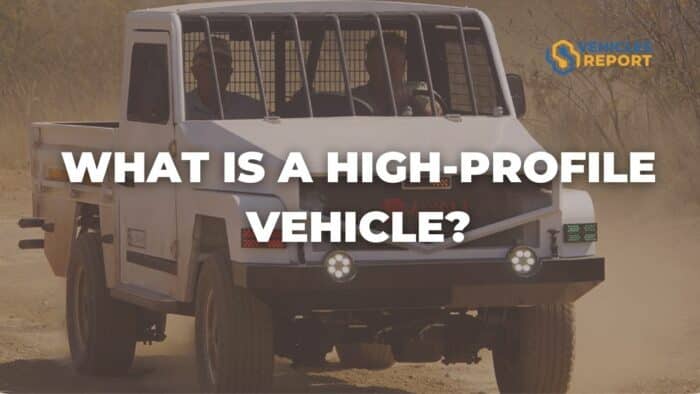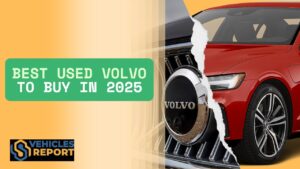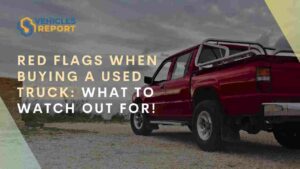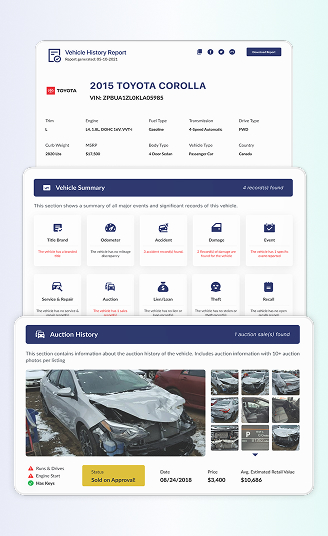When you hear the term “high profile vehicle,” you may be tempted to think it means some mega, classy car like the Bugatti La Voiture Noire or the Rolls-Royce Boat Tail, but that’s actually far from accurate. High-profile vehicles are typically taller and broader than regular cars, and they include a variety of vehicles such as semi-tractor trailers, buses, and recreational vehicles (RVs). In this article, we will take a look at the details of what makes a vehicle high-profile and why it matters. We will also provide tips for used car buyers in need of high-profile vehicles. So, fasten your seatbelts, and let’s get started!
What is a high-profile vehicle?
When we refer to a high-profile vehicle, we are talking about any vehicle with a large side surface area. These vehicles are characterized by their larger dimensions, which result in a higher center of gravity and increased susceptibility to external factors such as wind gusts. Their distinctive features often make them stand out on the road, and they require special attention and precautions while driving. Yes, you read that right. The fact that your vehicle seems bigger than others doesn’t mean it has no problems. You even need to be extra careful on the road.
Have you ever noticed that sign on the road that warns high-profile vehicles about high wind?” Well, these high-profile vehicles are more likely to be difficult to control when there is high wind. So drivers need to be extremely cautious.
Types of high-profile vehicles
Some common examples of high-profile vehicles include semi-tractor trailers, buses, recreational vehicles (RVs), box trucks, pickup trucks, SUVs, and large commercial vans. These vehicles are designed to carry substantial loads, and as a result, their overall height and length are increased. Due to their significant size and weight, high-profile vehicles have unique considerations that drivers and other road users should be aware of.
Semi-Tractor Trailers
Semi-tractor trailers, also known as semi-trucks or 18-wheelers, are the backbone of the transportation industry. These vehicles consist of a powerful engine (the tractor) and a trailer for hauling cargo. Their large size and weight make them highly susceptible to wind effects, requiring skilled drivers to handle them safely on the road.
Buses
Buses are designed to transport a large number of passengers and are commonly used for public transportation, school transportation, and long-distance travel. With their tall and elongated structure, buses have a significant side surface area, making them high-profile vehicles. They require cautious driving and attention to passenger safety.
Recreational Vehicles (RVs)
RVs, also known as motorhomes or campers, are popular for road trips and camping adventures. These vehicles combine living quarters with a motorized vehicle, providing both transportation and accommodation. RVs come in various sizes and designs, but most have an elevated profile, making them high-profile vehicles that require additional care when driving.
Box Trucks
Box trucks are commonly used for commercial purposes, such as transporting goods and making deliveries. These trucks feature a box-like cargo area attached to a cab. While they are not as large as semi-trucks, box trucks still have a high-profile design due to their box-shaped structure, demanding careful maneuvering on the road.
Pickup trucks and SUVs
While not as large as some of the other high-profile vehicles, pickup trucks and SUVs can still fall into this category. With their elevated ride height and often spacious design, they have a larger side surface area compared to regular passenger cars. It’s important for drivers of these vehicles to be mindful of their higher center of gravity and adjust their driving accordingly.
Large commercial vans
Large commercial vans, such as cargo vans used for delivery services or passenger vans used for group transportation, can also be considered high-profile vehicles. These vans typically have a taller and wider structure, providing ample cargo or passenger space. Drivers of large commercial vans need to be aware of their vehicle’s size and potential wind effects during operation.
Factors Affecting High-Profile Vehicle Dynamics
As earlier mentioned, wind has a very big effect on high-profile vehicles on the road, and without appropriate measures, anyone could get into an accident. The two major factors affecting the dynamics of these vehicles include:
Wind Effects
High-profile vehicles are particularly vulnerable to the influence of wind due to their large surface area. Crosswinds can push these vehicles sideways, potentially leading to a loss of control or even tipping over. It’s crucial for drivers of high-profile vehicles to be aware of weather conditions and adjust their driving accordingly.
Weight Distribution
The distribution of weight within a high-profile vehicle plays a critical role in its stability. Improper loading or unbalanced weight distribution can affect the center of gravity and increase the likelihood of rollovers or swaying motions. Proper loading and weight distribution are essential for safe operation.
Now you understand why you must be careful while driving on the road whenever it’s really windy. More specifically, drivers should learn to be as cautious as they normally are while driving when it’s snowy.
Safety measures and driving tips for high-profile drivers
To drive your high-profile vehicle safely during high winds, there are some safety measures and driving tips that you need to understand. Here are some tips every high-profile driver should know before driving in windy conditions:
- Be aware of wind conditions and adjust your driving accordingly.
- Maintain a safe following distance and allow for longer stopping distances.
- Practice proper weight distribution and loading techniques.
- Conduct regular maintenance checks on tires, brakes, and mechanical components.
- Drive at a controlled speed and be patient on the road.
- Anticipate and be attentive to potential hazards.
- Avoid high-wind areas when possible.
- Give high-profile vehicles ample space and avoid sudden lane changes.
- Be mindful of your blind spots and avoid lingering in them.
- Ensure clear visibility by adjusting mirrors and using turn signals effectively.
Remember, these safety measures and driving tips are crucial for high-profile vehicle drivers to enhance safety and reduce the risk of accidents on the road. Don’t skip them; make sure you read and understand these tips. They could save your life.
Should I buy a used semi-tractor trailer?
Don’t let this windy situation scare you away from buying any high-profile vehicle you are interested in. However, before you pay for that used semi-tractor trailer, bus, recreational vehicle (RV), box truck, pickup truck, SUV, or large commercial van, we’d recommend that you carry out a VIN check and generate a vehicle history report from Vehicles Report to gain full access to the vehicle’s history and records and make the best decisions.
High-profile vehicles are susceptible to accidents when there’s high wind, so you must verify if the vehicle has been in an accident before and the damages sustained. This way, you can also identify potential defects, and with the Vehicles Report, you can instantly get this information in seconds. Some of the details contained in our report include:
- Accident history
- Auction records with more than 10 photos
- Sales history
- Damage records
- Vehicle specifications
- Lien and loan records
- Open recalls
- Theft records
- Ownership history
- Title-brand records
- Warranty information
- OEM maintenance schedules
- Service history, and more
By generating a vehicle history report from Vehicles Report before committing to the purchase of any high-profile vehicle and following the recommended safety measures and driving tips, both drivers of high-profile vehicles and other road users can contribute to safer journeys for everyone. Remember, it’s all about sharing the road and being mindful of one another’s presence. Drive safely!
Frequently Asked Questions
What are large-profile vehicles?
Large-profile vehicles are vehicles that have a significant size and height compared to regular passenger cars. These vehicles typically have a larger side surface area, making them more susceptible to wind effects and other unique challenges on the road.
What is a high vehicle?
A high vehicle refers to any vehicle that has an elevated height or a higher ground clearance compared to standard passenger cars. These vehicles may include pickup trucks, SUVs, vans, or other types of vehicles that offer increased clearance from the ground.
What is an example of a high-sided vehicle?
An example of a high-sided vehicle is a box truck. Box trucks typically have a box-shaped cargo area attached to the cab, providing ample space for transporting goods. Due to their tall and elongated structure, box trucks have a significant side surface area, making them high-sided vehicles. Other examples of high-sided vehicles include certain types of vans, large commercial vehicles, and some SUVs with higher rooflines.








